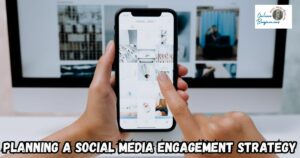In today’s fast-scrolling world, content is king—but not all content is created equal. If you’ve ever wondered whether to write a blog post or design an infographic, you’re not alone. Understanding the strengths and weaknesses of written and visual content can help you build a smarter, more effective content strategy. So, what’s the better option? Let’s dive into the pros and cons of written content vs. visual content.
What Is Written Content?
Written content includes anything made up of text—think blog posts, articles, white papers, product descriptions, eBooks, and social media captions. You’ll find written content on websites, emails, newsletters, eCommerce platforms, and just about anywhere online where people are searching for information.
What Is Visual Content?
Visual content refers to graphics, videos, images, infographics, memes, animations, and even live streams. If it’s visual and not just text, it falls under this category. Visuals are everywhere—on YouTube, Instagram, TikTok, Pinterest, and embedded in websites. They dominate social media and, increasingly, search engine results too.
The Pros and Cons of Written Content
| Pros of Written Content |
|---|
| SEO benefits: Written content like blog posts, articles, and website text can be optimized with keywords to improve search engine ranking and attract organic traffic. This makes it easier for potential customers to find your content when they search for information related to your products or services. |
| Detailed explanation: Written content allows for in-depth exploration and explanation of complex topics, concepts, or products, providing a comprehensive understanding for the audience. It says that written content with headings, subheadings, and bullet points improves readability and allows readers to quickly find the information they need. |
| Establish authority: Well-researched and informative written content positions your brand as a knowledgeable and credible source in your industry, building trust and respect with your audience. |
| Affordability: Written content is often less expensive and quicker to produce compared to high-quality videos or complex infographics, making it a viable option for businesses with budget constraints. |
| Accessibility: Written content is accessible to a wider audience, including individuals with visual impairments or those who prefer to consume information through reading. |
| Cons of Written Content |
|---|
| Time-consuming production: Creating high-quality, well-researched written content requires significant time and effort for research, writing, editing, and potentially optimizing for SEO. |
| Lower engagement potential: Written content may not generate the same level of immediate engagement and shareability as visually appealing content like videos or images. |
| Difficulty standing out: In a crowded online landscape, text-heavy content can struggle to capture attention and stand out amidst the abundance of information available. |
| Results aren’t immediate: Building brand awareness and authority through written content can be a long-term process, with results taking time to materialize. |
The Pros and Cons of Visual Content
| Pros of Visual Content |
|---|
| Quick attention grab: Visual content like images, videos, and infographics is processed much faster by the brain than text, making it highly effective at capturing and holding attention. |
| Increased engagement: Visuals are highly shareable on social media and other platforms, increasing engagement and potentially leading to viral content. |
| Emotional connection: Visuals can evoke emotions and create a stronger connection with the audience, making your brand more memorable and relatable. |
| Simplified complex information: Infographics and videos can break down complex ideas into easily digestible and shareable formats, improving comprehension. |
| Boosts social media presence: Visual content is highly favored on platforms like Instagram and TikTok, driving increased brand visibility and engagement. |
| Influences purchasing decisions: High-quality visuals like product demos or testimonials can influence purchasing decisions and drive higher conversion rates. |
| Cons of Visual Content |
|---|
| Time and cost of production: Creating high-quality visual content, especially videos, can be time-consuming and expensive, requiring specialized skills, equipment, and editing software. |
| Less SEO impact: Relying solely on visual content can reduce the SEO benefits associated with keyword-optimized written content. |
| Limited flexibility: Updating visual content, like videos or infographics, can be more challenging and time-consuming than revising written text. |
| Accessibility concerns: Some visual content, like images without alt text or videos without captions, may not be accessible to individuals with visual or hearing impairments. |
| Overreliance can lead to misinterpretation: Using too many visuals or relying heavily on them without sufficient context can lead to information overload or misinterpretation. |
Choosing the right The best content marketing strategy often involves a combination of both written and visual content, leveraging the strengths of each format to achieve your specific marketing goals. Consider your target audience’s preferences and the type of information you want to convey when deciding which format or blend of formats to prioritize.
Crafting a well-researched article takes time, often more than a quick infographic or short-form video.
When to Use Written Content
Written content is a versatile tool in marketing and can be effectively used at various stages of the buyer’s journey, from building awareness to driving sales. It’s particularly valuable for providing information, establishing brand authority, and boosting search engine optimization (SEO).
Here’s a more detailed look at when written content is most effective:
1. When educating your audience:
- Awareness Stage: Written content like blog posts, articles, and ebooks can be used to introduce your audience to a problem they might not even realize they have, and then introduce your solution.
- Consideration Stage: As customers move further down the funnel, they’ll be looking for more in-depth information to help them evaluate different solutions. Written content can provide detailed explanations, comparisons, and case studies to guide their decision-making.
2. When building trust and authority:
- Establishing Expertise: Consistently publishing well-researched and informative content demonstrates your knowledge and expertise in your field, building trust with your audience.
- Long-term Engagement: Quality content keeps your audience coming back for more, fostering a strong and lasting relationship.
3. When optimizing for search engines:
- SEO: Well-written content with relevant keywords is crucial for improving your website’s ranking in search engine results.
- Driving Traffic: Optimized content helps potential customers find you when they are searching for information related to your products or services.
4. When nurturing leads:
- Email Marketing: Content-rich emails build relationships with your audience and provide value, making them more receptive to future sales messages.
- Sales Funnel Optimization: Use written content to guide prospects through the sales funnel, providing them with the information they need at each stage.
5. When you need to be concise and clear:
- Skimmable Content: Many online readers prefer to skim content. Use clear headings, bullet points, and short paragraphs to make your content easy to digest.
- Active Voice and Conciseness: Using the active voice and avoiding unnecessary jargon helps ensure your message is clear and easily understood.
By carefully considering the stage of the buyer’s journey and your specific marketing goals, you can effectively leverage written content to build your brand, engage your audience, and drive conversions.
When to Use Visual Content
Visual content is most effective in marketing when used to grab attention, tell a story, explain complex information, enhance engagement, and boost shareability, especially on social media platforms. It can also be used to build brand trust and improve lead generation.
Here’s a breakdown of when to use visual content in marketing:
- 1. When you need to capture attention quickly: Visual content, like images and videos, is processed much faster by the human brain than text. This makes it ideal for grabbing attention in a crowded digital space.
- 2. When you want to tell a story: Visuals can be a powerful storytelling tool, allowing you to showcase your brand’s journey, highlight your products or services, and connect with your audience on an emotional level.
- 3. When explaining complex information: Infographics, graphs, and charts can simplify complex data or processes, making them easier for your audience to understand and retain.
- 4. When boosting engagement on social media: Platforms like Instagram, TikTok, and Facebook prioritize visual content. Visuals can significantly increase engagement metrics like likes, shares, and comments.
- 5. When building brand trust and credibility: High-quality visuals, like behind-the-scenes photos, videos of your team, or customer testimonials, can help humanize your brand and build trust with your audience.
- 6. When improving lead generation: Visual content like ebooks, videos, and infographics can be used to establish your expertise and provide value to potential customers, helping you generate leads.
- 7. When enhancing email marketing: Visuals in email campaigns can make your emails more engaging and increase open and click-through rates.
- 8. When improving search rankings: Images and videos can increase dwell time on your website, which is a signal used by search engines to determine content quality.
The Power of Combining Both
Written Content + Visuals = Best of Both Worlds: Why choose one when you can have both? Blog posts with infographics, articles embedded with videos, or social media captions paired with memes can skyrocket engagement.
Case Studies and Examples: Think of HubSpot or Neil Patel—they crush it using blogs loaded with images, graphs, videos, and clear writing. That’s a hybrid strategy in action.
Trends Shaping the Future of Content
Rise of Video and AI-Generated Media: Short-form video and AI tools like DALL·E and Sora are changing the game. Expect more mixed-media and auto-generated content.
Interactive and Hybrid Content Formats: Quizzes, sliders, animated infographics—interactive content is becoming more common, blending visual and text elements in engaging ways.
FAQs On Visual vs Written Content
Which content type is better for SEO?
Written content generally outperforms visual content in SEO due to keyword integration, crawlability, and structured formatting.
Can visual content be optimized for search engines?
Yes, with proper use of alt text, file names, meta tags, and surrounding text, visual content can support SEO, just not as strongly as text.
How do I decide which content to use?
It depends on your audience, platform, and goals. Use written content for depth and searchability, and visual content for engagement and virality.
What are the best tools for creating visual content?
Canva, Adobe Creative Suite, InVideo, and Lumen5 are top tools for visuals. They help create infographics, videos, and animations without needing design skills
How often should I update written content?
Ideally, review and update evergreen articles every 6–12 months to keep them relevant, accurate, and competitive in search rankings.
Conclusion: So, written vs. visual—who wins?
The truth is, they’re both champions in their own right. Written content builds depth, SEO authority, and long-term value. Visual content wins attention, shares, and emotional engagement.
The best strategy? Don’t pick sides. Instead, blend both to capture your audience across platforms, preferences, and touchpoints. Play to their strengths, and your content will always win.
Check Out Our Most Recent Articles:
- Video Content: 6 Tips for Boosting Engagement On Social Platforms

- A 4 Phase Guide to Creating Platform-Specific Content

- Analyzing Social Media Metrics For Content Success

- The Impact Of AI On Content Personalization

- How To Build A Social Media Engagement Strategy in 7 Steps

- How To Develop A Consistent Brand Look And Feel

Wishing You Much Success With Your Content Creation,

- onlinebenjamins.com
- thebeachangler.com
- thesinnerinthemirror.com
- Facebook: Online Benjamins
- Twitter: @onlinebenjamin1
- Instagram: dotcomdinero
- YouTube: Online Benjamins
Rex
P.S. Again, Wealthy Affiliate is COMPLETELY FREE to get started. No catch, no obligation, no bait and switch. I will personally be in touch with you upon joining to offer my support and guidance to help you get up and running online.
P.P.S. If you have any questions or are unsure of anything, I am here, and I promise I will get back to you on all of your questions and comments. Just leave them below in the comment section. Follow me on Twitter: @onlinebenjamin1, Instagram: dotcomdinero, and Facebook: Online Benjamins.
Hi,
Thanks for stopping by and congratulations for taking the first steps to building your own online business. I’ve been in business both offline and online since 1997. I would consider it an honor to help you build your business. Father of 3, life long outdoorsman with an education in Genetics and Economics. This site is about cutting through the BS and finding the real opportunities in the online world. I look forward to working with you.



